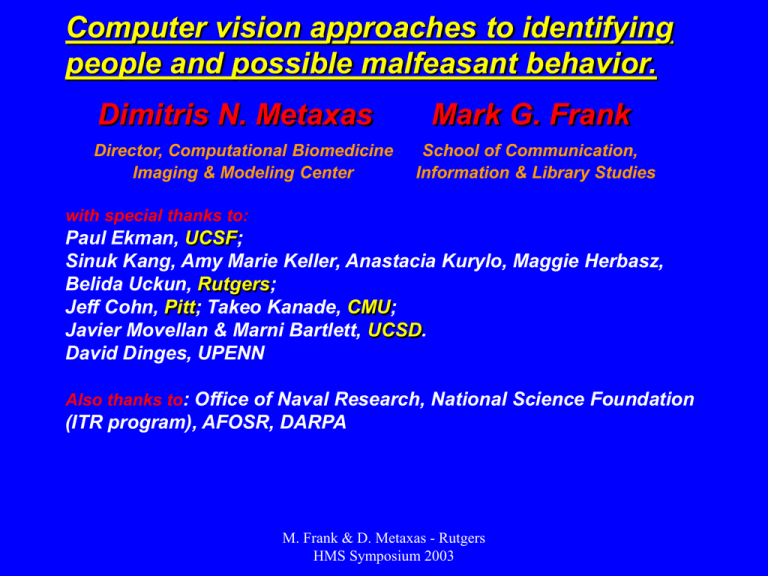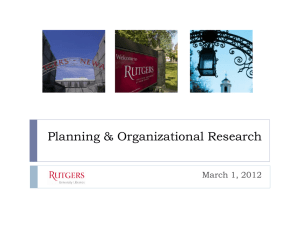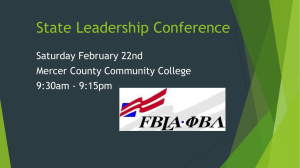Computer vision approaches to identifying people and
advertisement

Computer vision approaches to identifying people and possible malfeasant behavior. Dimitris N. Metaxas Director, Computational Biomedicine Imaging & Modeling Center Mark G. Frank School of Communication, Information & Library Studies with special thanks to: Paul Ekman, UCSF; Sinuk Kang, Amy Marie Keller, Anastacia Kurylo, Maggie Herbasz, Belida Uckun, Rutgers; Jeff Cohn, Pitt; Takeo Kanade, CMU; Javier Movellan & Marni Bartlett, UCSD. David Dinges, UPENN Also thanks to: Office of Naval Research, National Science Foundation (ITR program), AFOSR, DARPA M. Frank & D. Metaxas - Rutgers HMS Symposium 2003 M. Frank & D. Metaxas - Rutgers HMS Symposium 2003 Signals relevant to counter-terror. • • • • Identification of bad guys Changes in gait with loads as small as 1 kg Anger prior to imminent attack Fear/distress when lying M. Frank & D. Metaxas - Rutgers HMS Symposium 2003 Take a closer look… Kim Philby, 1960’s (Frank & Ekman, 2003) M. Frank & D. Metaxas - Rutgers HMS Symposium 2003 How lies are betrayed. Lie Cognitive clues Emotional clues - Contradictory statements - Hesitations -Speech errors -Reduced illustrators -Contradictory emblems -Reduced detail -Etc. Lying about feelings Feelings about lying -Look for reliable signs of emotion -Duping delight -Guilt -Detection apprehension M. Frank & D. Metaxas - Rutgers HMS Symposium 2003 The Facial Action Coding System (FACS) Ekman & Friesen, 1978 46 Action Units Action code: 1, 2, 4, 5, 7, 20, 26 1 Inner brow raise 2 Outer brow raise 4 Brow lower 5 Upper lid raise 7 Lid tighten 20 Lip stretch 26 Jaw drop M. Frank & D. Metaxas - Rutgers HMS Symposium 2003 Challenges facing behavioral science: • Advantages: - reliably identify people & behaviors - non-obtrusive - non-inferential, allows for discovery • Disadvantage: - laborious - mistaken identity via cognitive capacity, disguise, etc • Solution - automatic computer vision techniques M. Frank & D. Metaxas - Rutgers HMS Symposium 2003 Gait recognition • Identify people from the way they walk • Important for surveillance and intrusion detection • What are good features for identifying a person? – i.e., what features are person-specific? M. Frank & D. Metaxas - Rutgers HMS Symposium 2003 Background Sagittal plane - divides body into left and right halves Limb segment - a vector between two sites on a particular limb M. Frank & D. Metaxas - Rutgers HMS Symposium 2003 Elevation Angles M. Frank & D. Metaxas - Rutgers HMS Symposium 2003 The trajectories of the sagittal elevation angles are invariant across different subjects. As a consequence, person-independent gait recognition will require less training data. (Borghese et al., 1996) M. Frank & D. Metaxas - Rutgers HMS Symposium 2003 The cyclogram • Elevation angles trace curve in a 4D space • Curve is called “cyclogram” • Cyclogram lies in a 2D plane – Well, almost • Hypothesis: deviation of cyclogram from plane is person-specific M. Frank & D. Metaxas - Rutgers HMS Symposium 2003 Cyclogram example Curve is cyclogram projected into best-fit plane Green points are real points of cyclogram Red lines trace the deviation of points from plane (exaggerated scale) M. Frank & D. Metaxas - Rutgers HMS Symposium 2003 Cyclogram sequence • Deviation from cyclogram plane can be represented as a sequence • e.g., CCCGTTTTATATTTTTAAAAGCCGGTAAATTAGGGG • Compare sequences between people via longest common subsequence (LCS) matching – Well-known dynamic programming algorithm, used in computational biology M. Frank & D. Metaxas - Rutgers HMS Symposium 2003 Examples of People Detection M. Frank & D. Metaxas - Rutgers HMS Symposium 2003 Examples of Gait Analysis M. Frank & D. Metaxas - Rutgers HMS Symposium 2003 Face: Tracking: Stress Recognition • Identify which Facial Features (space and time) are important to recognize stress • Assymetries and Movements around the mouth and eyebrows M. Frank & D. Metaxas - Rutgers HMS Symposium 2003 Slope = Asymmetry A horizontal line would indicate no asymmetry. This facial expression, however, is generally slanted upward and to the left. M. Frank & D. Metaxas - Rutgers HMS Symposium 2003 asymmetry Plots of high and low stress time Expression of high stress in form of asymmetrical facial expression M. Frank & D. Metaxas - Rutgers HMS Symposium 2003 asymmetry In contrast, low stress time M. Frank & D. Metaxas - Rutgers HMS Symposium 2003 Some more high stress from different subjects M. Frank & D. Metaxas - Rutgers HMS Symposium 2003 Face: Tracking: Stress Recognition M. Frank & D. Metaxas - Rutgers HMS Symposium 2003 Face: Tracking: Stress Recognition M. Frank & D. Metaxas - Rutgers HMS Symposium 2003 M. Frank & D. Metaxas - Rutgers HMS Symposium 2003 Subtle brow changes important. M. Frank & D. Metaxas - Rutgers HMS Symposium 2003 Technical Challenges. • Pose • Head motion • Occlusion from glasses, facial hair, rotation, hands • Talking • Video quality • Frame rate (blinks) M. Frank & D. Metaxas - Rutgers HMS Symposium 2003 Conclusions. • There are reliable means to identify people as well as behaviors associated with deception and hostile intent. • We can detect these behaviors. • We can represent them digitally. • Can this make us more secure? M. Frank & D. Metaxas - Rutgers HMS Symposium 2003






